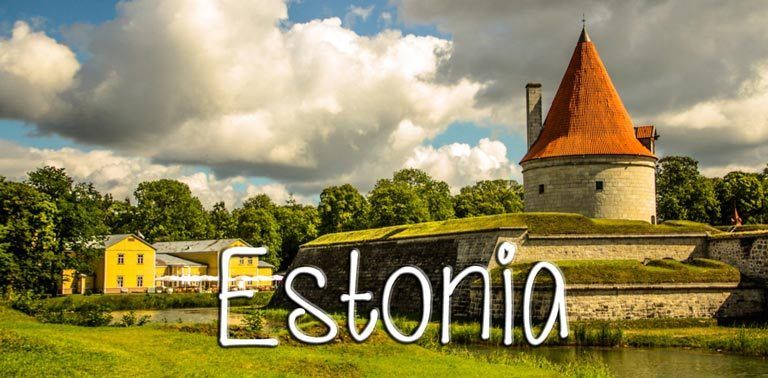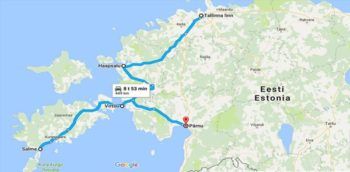
Road trip in Estonia, August 2017
 Farewell Finland, see you again! We crossed the Gulf of Finland from Helsinki to Tallinn in the beginning of August by an Eckerö lines ferry m/s Finlandia. Crossing to Estonia takes about 2 hours, and the price starts from around 60 euros for 2 persons with a car, depending the timing and the ferry company (for us it was 62 € when booked 2 days in advance). Unlike our original plan, we decided not to spend time in capital city Tallinn at this point, even if it is a very lovely city, but headed to explore the west coast instead.
Farewell Finland, see you again! We crossed the Gulf of Finland from Helsinki to Tallinn in the beginning of August by an Eckerö lines ferry m/s Finlandia. Crossing to Estonia takes about 2 hours, and the price starts from around 60 euros for 2 persons with a car, depending the timing and the ferry company (for us it was 62 € when booked 2 days in advance). Unlike our original plan, we decided not to spend time in capital city Tallinn at this point, even if it is a very lovely city, but headed to explore the west coast instead.
Haapsalu
After around 2 hours of driving and enjoying the wooded landscapes, we stopped for the night in Camping Pikseke in Haapsalu (place for tent 15 €). The next day was spent wandering around Haapsalu, mostly in the picturesque old town. No wonder that this old spa holiday destination, that was once popular among Russian aristocracy, is still busy during summer months. The old town with narrow streets, colorful wooden houses, cute cafes and reasonably-priced restaurants is absolutely charming.
Photographers surely love also the waterfront of lake Väike viik, which is rounded by a narrow walking trail, and provides a beautiful frame for photos of the old town. There is also a memorial for the world-famous Russian composer Pjotr Tchaikovsky, who stayed and worked in Haapsalu in 1867. Story tells, that the bench-shaped memorial is located in the exact spot where Tchaikovsky used to admire the sunrise and the swans swimming by.
And then there is the castle! Haapsalu Bishop’s Castle and Cathedral, which was established in 13th century, is considered as one of the best preserved castles in Estonia. You can wander inside the outer walls free-of charge, but for the museum complex and bell tower there are 5 € tickets for adults. Castle area provides a breath-taking setting for the yearly blues festival called Augustibluus, that was just being built when we visited the town. We considered staying couple of days longer to participate the festival, but finally decided to stick with the plan and head to the islands instead.
Before leaving Haapsalu behind we still visited the outside areas of the Railway and Communications Museum in Haapsalu. Old railway yard is full of nostalgic, long-time-ago retired locomotives, railway carriages and historical buildings and structures. We didn’t visit the small exhibition hall in the terminal building, but with reasonable price of 4 euros you can check that out as well.
Saaremaa Island
Our next destination was Estonia’s largest island, Saaremaa. We drove to port of Virtsu, and boarded a pretty modern and stylish ferry Tõll. Crossing to Muhu Island next to Saaremaa took about a half an hour, so there was time for some snacks and a small beer. Price level here in Estonia, even when on a ferry, is really friendly, especially if you happen to come from as pricey country as Finland of course… You can easily get a decent meal (like soup, salad, burger and so on) with 5 euros and a large beer even in a bit finer restaurant costs somewhere between 3 to 4 euros.
Accommodation is not that expensive in Estonia either, let’s say that with 30 euros it’s easy to find a really nice room, and there are also cheaper options available. We decided to continue camping however, and headed to Tehumardi Camping in the small village by the same name. The camping site is really nice and equipped with a decent kitchen and a lounge area with strong enough wifi that you can actually work. There also are several campfire places, some sports fields and even a pond for swimming. A place for a tent cost 12 € per night.
During our three days stay in Saaremaa we took our time to explore the island (which is surprisingly large and forested), work on the blog and other FinnsAway-related stuff, run and roller skate through the beautiful landscapes and to taste some local beers from small breweries. We checked out some of the most famous sights on the island: Pangla cliffs were nice, but not that high or impressive after walking along some breath-taking cliffs in Gozo Island (Malta) or in Wales for example. Windmills of Angla (some of them also elsewhere in the island) were a pleasant sight and remembrance of the way of living on the island decades ago. Some older history was at hand when visiting the Maasi Fortress ruins. Construction of the castle started on 14th century, and it was destroyed in 16th century, but parts of the fortress are well-preserved and work is ongoing to resurrect and clean more.
On top of the main sights, we also paid a visit to the biggest city of Saaremaa, Kuressaare, which is an idyllic and quiet town with around 13 000 inhabitants. During the holiday season it is busy with visitors who either stay in the town or, like us, come for a day visit to check out the sights, to have a meal in one of the welcoming restaurants and to do some grocery shopping. The top 1 sight in Kuressaare is the Kuressaare Episcopal Castle from 14th century, and the surrounding, picturesque castle park. You can wander around the castle area for free, but in the central building is the Kuressaare Museum, for which the tickets cost 6 € for adults. After walking around the castle park and along the old town streets we had a lunch in one of the restaurants serving traditional Saaremaa dishes, and tasted the home-brewed beer which has a long tradition on the island.
Parnu
Next stop on our way through the Baltic countries was the city of Pärnu, located in southern Estonia, on the coast of Pärnu bay. We had shortly visited the city just couple of years ago, but in such hurry that we hardly paid a visit to the center. So this time we stayed for two nights, and had time for sports and wandering around the small city center. Pärnu has a long history as a spa destination, and it’s nowadays knows as Estonia’s summer capital.
There is a long sandy beach with a beach promenade just next to the city center, and pretty much everything seems to be within walking distance. There are some interesting sights like Tallinn gate, which dates back to 17th century, several churches, Pärnu town hall and other historical buildings. Old town is dotted with restaurants, most of them having comfy terraces for eating / drinking in the open air. Our first days in Estonia were a bit chilly, since there had been strong winds from the sea, but while in Pärnu, the weather turned perfectly sunny and warm, a very welcome change!
Next we will head south to Latvia, stay tuned for more travel stories!
Coming up is also a post about some recommendations from our stay here in Pärnu, where we switched from camping to sleeping indoors 🙂
